News bulletin 1
News of April, 2008
A. Donation of Stichting Milijuli to the Jana Jyoti Primary School in Duble
In March I have been in Nepal again. In Kathmandu I had a meeting with Pradeep Tamang and Kama Dawa Sherpa, representatives of Dublelee Milijuli Samuha. We discussed how to spend the 1400 Euro, that Stichting Milijuli is prepared to donate to the school in Duble. We already had started a discussion via e-mail, but talking face to face is always preferable.
For Stichting Milijuli highest priority is to secure that all children from Duble and neighborhood who like to attend school, can do so. If there is still money left after this is secured, we like to spend it for another education project. Further we want to assure the children and their parents, that we will help them for a period of not less than 5 years.
We agreed upon the following:
- in Duble there are 16 children in a difficult situation. These are orphans, children missing one parent, disabled children and Dalits (untouchables - not belonging to any caste: http://en.wikipedia.org/wiki/Dalit ). To help these children we donate 200 Euro, each year, as a compensation for the costs of educational aids.
- one of the teachers, Janga Tamang, is underpaid. For this teacher we donate 100 Euro per year as an addition to his low salary.
- depending on further gifts to Stichting Miliuli, the present term of 5 years can be extended and the amounts can be raised.
B. Further items selected from the discussion
Pradeep and Kama Dawa would be very glad if one of the 16 children, the one who is best in studies, could attend a boarding school in Kathmandu. The costs for the first two classes would be 50 Euro per month.
The Jana Jyoti Primary School in Duble has now 131 students.
The school is a governmental school with 5 classes. Attending such a school is for free. However, the parents still have to pay for educational aids.
The school board likes to upgrade to 10 classes, so that the students can qualify for the national SLC (School Leaving Certificate). For classes 6 to 10 the parents have to pay school fees. In Kiji there is a school with 10 classes. However, the walking distance is more then 2 hours.
The school has two nursery classes. As there is not sufficient money to pay for that, two teachers work for a very low salary. One is working part-time. He also runs a shop. The other, Janga Tamang, works full-time. We donate 100 Euro per year to raise his salary. For a decent salary he needs a raise of another 100 Euro.
The school in Bhite has found a good sponsor (see: http://www.schoolindehimalaya.nl). Therefore Dublelee Milijuli Samuha now pays most attention to the Jana Jyoti Primary School in Duble.
C. Visit to Duble
I was in Nepal together with family member Jan. In 2000 we were together in the Everest area. As we had planned a trekking to Duble, Pradeep en Kama Dawa proposed that we hand over the first 300 Euro personally. They would arrange a meeting with the children, who we were going to help. We decided to bring also some useful presents - for each child an exercise-book, a pencil, a rubber and a sharpener. For the headmasters' room we had a desk-mountable pencil sharpener and for general use two clocks. Even in the digital age children have to learn how to read an analog clock. Exercise-books can also be bought in rural areas, but often the quality is very low there. So, we had also work for an additional porter.
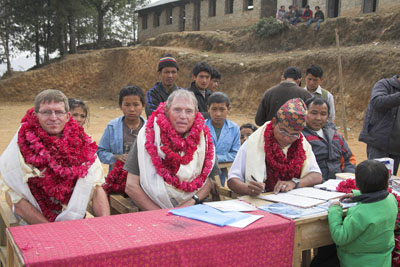
The reception at the school was fabulous. Despite the school holidays, most of the students and many parents were present. We were smothered with garlands of flowers and with kata's. The headmaster, Hem Bahadur Tamang entered everything in a journal and there were the inevitable speeches. The money was handed over to Nang Sere Sherpa. The children, who were present, received their exercise-books and other utensils. The gathering was concluded by a fotosession.
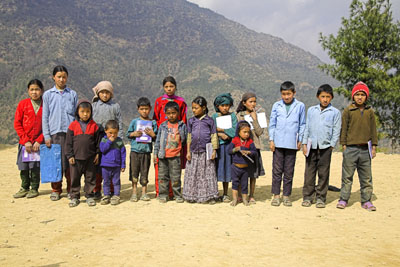
15 of the 16 children.
These are the children we help to buy educational aids.
It is normal that Mathbir was not present at the happening at the school. He has very bad sight.
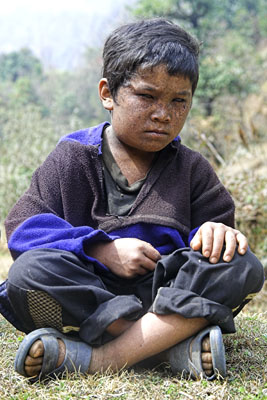
Here the 16th, Mathbir Tamang. I met him, his father and an uncle, when I was busy at the river.
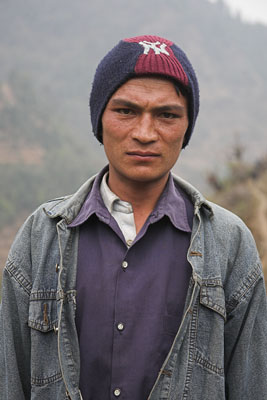
Left: Janga Tamang.
This teacher, Janga Tamang, receives from Stichting Milijuli a supplement to his salary. However, to pay him a decent salary, more money is needed.
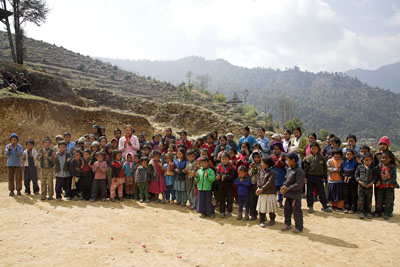
Top: Students of the Jana Jyoti Primary School in Duble
We stayed three days in Duble, as guests of Kame Sherpa. Too short, really. I had planned to take a picture of Duble like the one on the website, but more clear. I managed to do so and I will use the new picture in the next update for that page.
Electricity
When you visit small villages in the foothills of the Himalayas, electricity for lighting is always a good subject for conversation. The villagers like it very much to have sufficient electricity to light some lamps. With 400-500 Euros for a solar package you make one family happy, but helping a whole village will be a very expensive operation. The amount of energy needed for such an extension can be generated in a cheaper manner from the water that is flowing down the mountains all 24 hours of the day. That is why pico-hydro installations, generating up to 5 kW. are build at many locations.
[A disadvantage of solar cells for electricity is that you need batteries. Poor people tend to use the cheapest ones - lead batteries for cars. After their relatively short life-time they will be wasted in the environment].
Villages like Duble will not be connected to the grid in a foreseeable future. That is why I liked to judge the viability to construct a pico-hydro installation in Duble. In a first survey I followed the course of the river with a GPS. Further, I marked the position of the houses I came by. You can read my report as a PDF-document.
Sherpa wedding
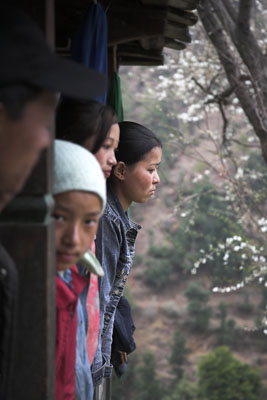
Bride Sumdja, at the balcony, on the look-out for her groom.
During our visit Sumdja ('third daughter'), daughter of Nang Sere Sherpa, married. Nang Sere Sherpa, president of Dublelee Milijuli Samuha, invited us Sherpa-wise by offering a small present. The festivities for a Sherpa marriage last two days. We could enjoy the first day. On that day, in the afternoon, the groom arrives at the home of the bride.
The second day the bride and groom go to the house of the groom.
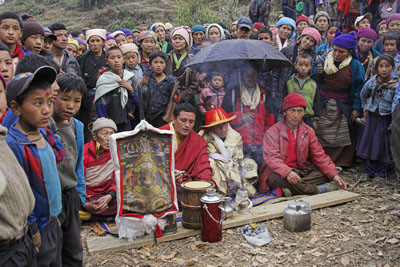
Sherpa groom flanked by 3 lama's
D. More pictures
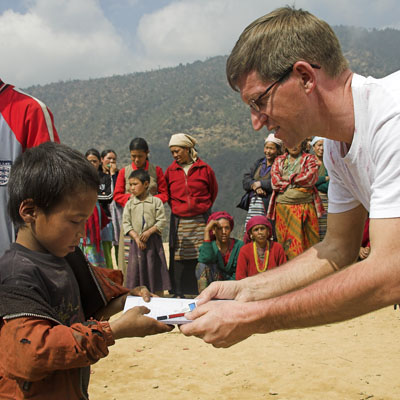
Jan, helping to distribute exercise-books etc.
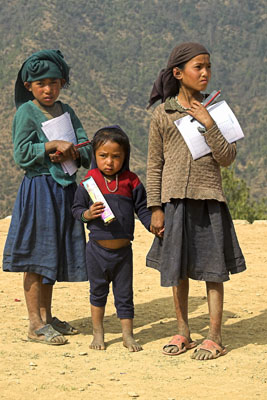
Children showing their presents
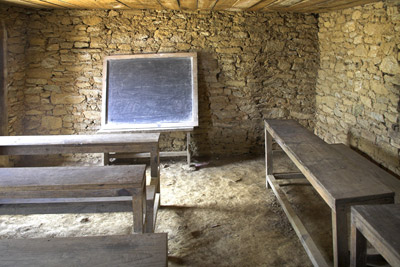
Classroom of the Jana Jyoti Primary School in Duble
Perhaps, in future, a wooden floor?
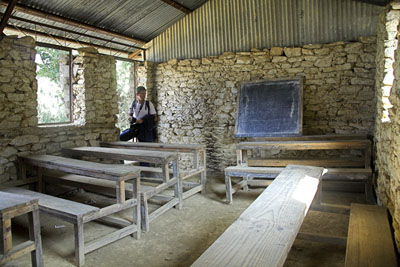
Another classroom.
...... and perhaps also glass in the windows and a wooden door, so that it is less cold in winter.
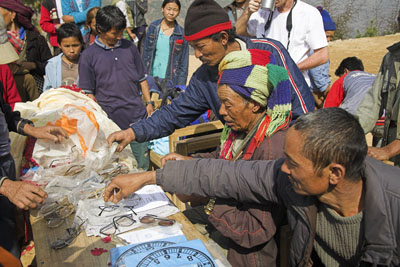
Can I find glasses with the right correction?
Nima, of Multiadventure, gave us glasses for the villagers. People are keen to find one with the right correction.
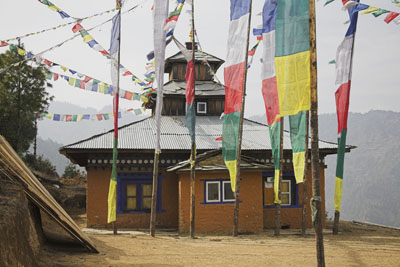
Samba Chhyoling Gumba Bikas Samiti in Duble
The Samba Chhyoling Gompa, for which construction started in 2001 was inaugurated end 2007. However, the building still needs some modification. The roof is leaking and sags under the load of the stone-sheets. Jan enjoyed telling how the construction could be improved. The people in Duble like to replace the stone-sheets by corrugated iron in red color (blue is for schools).
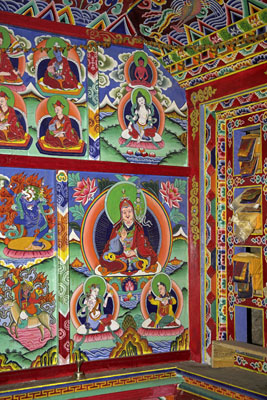
The Gompa now has a very nice decoration.
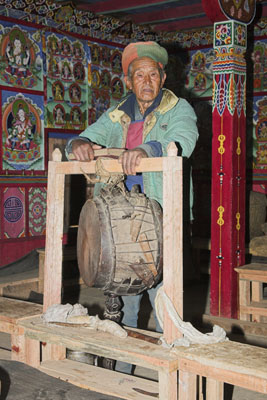
One of the many construction workers.
In 2001, I helped this Lama with digging the trenches for the fundaments of the Gompa.
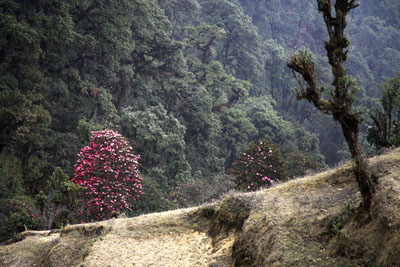

March is the time of the flowering rhododendron trees (in Nepali: Laaligurans).
... however, there are many other flowering plants.

Tree orchid.
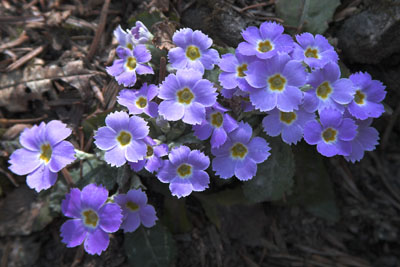
Primrose
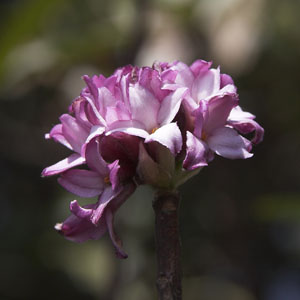
Flower of Mezereon.
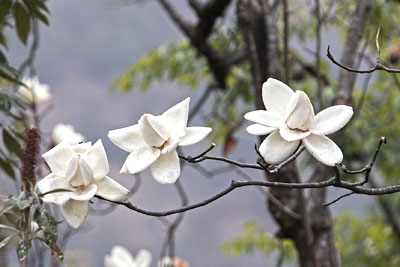
Until now, I did not find the name of this tree.
(Ton van der Kop)


